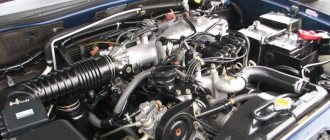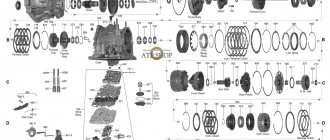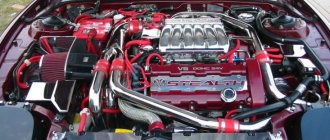08/12/2021 7,704 Transmission
Author: Victor
The CVT transmission belongs to the class of continuously variable transmissions. Cars began to be equipped with such gearboxes relatively recently. The Outlander variator is a structurally complex unit that requires careful use and timely maintenance. We will talk about this, as well as the disadvantages of CVT transmissions, below.
[Hide]
Design and principle of operation
First, let's look at how the CVT transmission works in a Mitsubishi car of 2008, 2010, 2011, 2012 and other years of production. The principle of operation is based on a smooth change in the torque of the power unit within the adjustment intervals established by the manufacturer.
Outlander CVT disassembled
The Outlander variator includes the following elements:
- the variator itself;
- clutch mechanism;
- device for activating reverse speed;
- control module.
In new and old Outlander cars, the operation of the CVT transmission is controlled by a control system that is designed to perform the following functions:
- clutch control, determining the moment to separate the gearbox from the power unit;
- control of the functioning of the planetary device;
- changing the gear ratio between transmission shafts;
- ensuring the operation of the reversing device to activate reverse gear.
The principle of operation of the CVT system in cars produced in 2013, 2014, 2015, 2016 and other years of production is based on the simultaneous change in the diameters of the drive and driven pulleys. The dimensions of these elements change through the action of a special drive. When the machine is stationary, the drive shaft has a small diameter, and the driven shaft has a large diameter. As a result of the start of movement and an increase in speed of the power unit, the dimensions of the elements change. As a result, the diameter of the drive shaft increases, and the diameter of the driven shaft decreases.
The transmission system control module receives data from various controllers. The operation of this device is related to the speed parameters of the power unit, the tire pressure, the functioning of the ABS traction control system, etc. The data entering the central processor is filtered. Therefore, the control module automatically adjusts the operation of the unit to a certain gear ratio. A key feature of Outlander CVTs is that such units cannot independently activate reverse gear in the car. To implement this function, vehicles use a planetary gearbox. Its operating principle is similar to that of a traditional automatic transmission.
Outlander variator chain
When the driver of a car with a CVT drives a vehicle, he performs the same actions as when working with an automatic transmission. But in this case, the car enthusiast only needs to select a certain mode, the control system will do the rest for him. Using the central processor, the gear ratio can be fixed.
When accelerating a vehicle, the crankshaft usually operates at the same speed, which is why many owners criticize the variator in their reviews because they do not feel the car accelerate as a result of a smooth increase in speed.
This operating scheme is relevant for all Outlander models, regardless of mileage and year of manufacture.
Oil selection and filling volumes
The manufacturer officially recommends using exclusively DIA QUEEN CVTF-J1 or DIA QUEEN CVTF-J4 oil. Since the variator is also used by other automakers, there are other suitable lubricants:
All of the above lubricants are manufactured using identical technologies at the production facilities of Total (ELF) and Idemetsu. Therefore, oils have similar properties, which is confirmed by numerous reviews from car owners.
The amount of oil required depends on the method of changing it. The table below describes the most popular methods.
Table - Required amount of oil depending on the method of changing it
| Way | Required volume, l |
| CVT filling volume according to documentation | 07.01.2019 |
| Replacement using a special device | 10.12.2019 |
| Partial replacement with removal of the pallet | 04.06.2019 |
| Draining oil through a special hole and then refilling it without removing the pan | 03.04.2019 |
The most preferred method of changing the oil is the method of removing the pan. This is due to the fact that at its bottom there are two magnets that catch metal shavings. Changing the oil without removing the pan is recommended only during the first maintenance. It is generally undesirable to use a special device to displace lubricant. It breaks off abrasive particles and spreads them throughout the variator. This significantly reduces the resource of the Mitsubishi Outlander continuously variable transmission.
Basic faults
Now let’s look at what problems and malfunctions affect the lifespan of CVTs in the Mitsubishi Outlander:
- Wear of cone bearings. If the bearing devices break down, the operation of the CVT transmission is accompanied by hum and noise. In practice, parts can fail after 50 thousand kilometers.
- Break in the variator chain. Outlander transmissions use metal belts consisting of steel plates connected to each other using special belts. The strap is in contact with the sides of the cone pulleys. The latter have special notches designed to improve grip. If these elements begin to wear out, this will lead to failure of the unit. Experts recommend checking the condition of the circuits from time to time.
- The need to repair the transmission unit may arise if the input controllers break down. We are talking about the transmission oil temperature sensor, the rotation regulator of the driven and drive shafts, pressure controllers in the main line, etc. If the devices break down, this is due either to their wear or mechanical damage. Sometimes the cause is liquid getting on the controller.
- Problems with the electronic control system. With such problems, it may be difficult to enable different operating modes of the gearbox. Often, when the electronic unit breaks down, the gearbox operates with jerks and kicks, and vibrates.
- Malfunctions in the operation of actuators and devices. We are talking about pressure solenoid valves in the main line, as well as in the driven pulley, planetary device, etc.
The video on the channel Ambulance for your unit shows the process of repairing the Outlander transmission.
Troubleshooting
You can check for errors in the operation of the gearbox using computer diagnostics. To do this, you can contact a service station or try to do everything yourself. To determine the problem, you will need a laptop with diagnostic software, as well as an adapter to connect to the diagnostic connector. Having connected to the plug, the verification utility is launched, which reads all the fault codes remaining in the memory of the control module. Using these codes you can decipher the problem.
How to solve problems with the checkpoint:
- Failed bearing elements must be replaced. Their use in a worn-out state will lead to destruction. As a result, bearing wear products can clog the channels of the lubrication system of the CVT unit.
- To prevent a serious problem, it is necessary to periodically check the condition of the circuit. A broken belt must be replaced.
- Input sensors fail rarely. Typically, a malfunction in their operation is associated with damage to the electrical wiring to which the controller is connected or a damaged or clogged connector. If the operation of a particular sensor causes problems, it is necessary to dismantle it and check the quality of the connection. Usually, after cleaning the contacts, the fault disappears. If both the contacts and wiring are intact, then the sensor needs to be replaced.
- If problems occur in the operation of the control module, you must contact a specialist. At home, solving the problem of the CPU not working is problematic. First of all, you will need to reflash the device and update to the latest software version. If this does not help, more detailed diagnostics will be required to identify errors. If the unit has mechanical damage or is exposed to moisture, then the cause of the breakdown may be a broken board. Only a qualified technician with the appropriate equipment can re-solder the circuit. A board that is faulty and cannot be repaired will have to be replaced.
- If no serious breakdowns have occurred, then problems in the operation of the gearbox can be eliminated by changing the oil. If the fluid regularly overheats and the system is not cooled sufficiently, the lubricant must be changed. Although Outlander CVT gearboxes are considered maintenance-free, they require periodic oil changes.
User Alexander Stepanov in his video spoke about problems in the operation of Mitsubishi Outlander CVT gearboxes.
Rules and terms of use
Now let’s look at how long it lasts on average and how to properly use and drive a CVT.
Outlander transmissions can operate in several modes:
- D. This mode is for forward driving. The position is considered basic. The transmission automatically changes the gear ratio based on the speed of the power unit.
- R. Reverse mode. Activation of this position is allowed after the vehicle has come to a complete stop.
- N. Neutral mode. When the driver engages this position with the lever, the transmission is switched off. Its activation is relevant during long-term parking or stopping. The neutral position can be used to start a car engine.
- R. Parking. When the driver turns on the parking mode, the driven shaft of the transmission unit is locked with a special pin, which prevents arbitrary movement of the car. Activation of the parking mode is allowed if the car is parked. To prevent accidental activation of parking, when installing the lever in the appropriate position, you must press the brake pedal.
As for the service life, according to the official regulations, the variator lasts as long as the entire operating life of the machine. This is 300 thousand kilometers. In fact, CVTs rarely work out such a resource. This is partly due to the quality of Russian roads, since CVTs are sensitive to regular vehicle use on uneven surfaces. The service life of the transmission is also affected by errors made during use.
If the Mitsubishi Outlander is used in off-road conditions, the service life of the CVT transmission will be reduced by 50%.
Learn about the symptoms of problems with a CVT transmission from a video filmed by the forwarder top channel.
The car owner should know that at low subzero temperatures the transmission needs to warm up. When starting the engine in the morning in winter, the engine warms up at low speeds. The gas pedal must not be pressed all the way until the internal combustion engine has warmed up. Please note that the engine warms up faster than the transmission. For optimal heating of the box with the engine running, it is necessary to move the gearbox selector to position D and R with the brake pedal pressed and hold in each mode for a few seconds. It is impossible to drive away abruptly with a cold transmission.
To increase the service life of the gearbox, you must adhere to certain rules:
- regularly check the volume of lubricant;
- The transmission oil change interval depends on its condition; usually the fluid needs to be changed every 60-100 thousand kilometers on average;
- use the car less for off-road driving, avoid slipping;
- pay attention to the instrument panel - if the transmission emergency mode indicator appears on it, it is necessary to perform computer diagnostics and determine the cause of the transmission malfunction;
- a car with a CVT cannot be used to tow other cars, as well as trailers weighing more than 500 kg;
- do not allow the transmission to overheat, and if a corresponding indicator appears on the dashboard, the car must be stopped and the cause determined;
- to prevent rapid wear of the structural elements of the gearbox, avoid aggressive driving, especially when the gearbox is not warmed up;
- When using the air conditioner frequently, experts recommend installing an additional radiator for cooling the liquid.
The AnTiNooB Stream / Live channel in its video talked about recommendations that will increase the service life of CVT.
Cooling the variator when overheated
According to reviews from owners, one of the problems that manifests itself in the operation of the variator is that the box gets hot. To prevent critical overheating of the transmission, you should not drive for a long time at high speed. As an option, you can additionally install a radiator device that will cool the unit more efficiently.
Oil selection and change
In Mitsubishi Outlander transmissions, only original oil is allowed. The manufacturer specially developed the product DIA QUEEN CVTF-J1 for CVT transmissions of these cars.
Changing consumables in Outlander boxes is done as follows:
- Start the car engine and warm it up to 70 degrees. The hotter the lubricant in the box, the more of it will come out of the system. The viscosity of warm oil is less than that of cold oil.
- Drive the car into a garage with a pit.
- Under the bottom of the vehicle, you need to remove the crankcase protection by first unscrewing the two screws at the front. There is no need to unscrew the remaining bolts, just loosen them. The protection itself is moved forward and dismantled.
- Place a container under the drain plug and then unscrew it. Old lubricant will begin to leave the transmission system. Assess her condition. If the oil contains traces of deposits or wear products, then more detailed diagnostics and flushing of the system will be required. The presence of metal shavings may indicate wear of bearing elements and other parts. If bearings fail, they must be replaced.
- Tighten the drain plug.
- Remove the dipstick from the level control hole and fill it with fresh oil. The same volume that was drained is filled.
- Start the car engine and warm it up. Turn on all transmission selector modes one by one. The lever must be in each position for at least half a minute. The process is repeated several times. This will allow fresh oil to pass through all channels of the system and mix with that part of the fluid that has not left the gearbox. It is impossible to drain all the oil from the transmission at one time.
- Stop the engine and drain the gearbox oil. This way, you can partially flush the system.
- Remove the bolts securing the pallet. When removing, be careful as some of the oil will come out. Assess the condition of the pallet. If there are wear products in the form of chips or deposits, it must be washed. For cleaning, use a special cleaner or acetone.
- Remove the transmission fluid filter. Rinse it thoroughly and dry it.
- There is a gasket around the perimeter of the pallet. Once removed, it will be damaged, so it needs to be replaced. Get rid of any remaining sealant using a utility knife. Install a new gasket, securing it to a layer of sealant.
- Replace the filter device. If you removed the magnets from the pallet, install them back. Place the pallet itself in place as well.
- Tighten the drain plug and fill the gearbox with fresh oil. The unit is filled with the same volume of lubricant that was drained.
- After this, the engine starts, the manipulation of turning on each mode is repeated for half a minute. Check the lubricant level in the gearbox using a dipstick. On a heated unit, the volume of liquid in the box should correspond to the HOT mark.
Drain the used lubricant from the gearbox
Remove the pan and replace the gasket on it
Clean the magnets from wear debris
Breaking stereotypes: Mitsubishi Outlander CVTs
Fifteen years ago the history of the Mitsubishi Outlander crossover began. The process of evolution of the model led to the appearance in 2007 of the Outlander XL, equipped with a CVT transmission. Since then, “many copies have been broken” on this topic, as a result of which negative stereotypes about the CVT have given way to its recognition
Based on materials from Mitsubishi Motors
As already mentioned, the honorable mission of introducing a CVT within the framework of the Mitsubishi Motors Co production program was entrusted to the Outlander XL crossover, equipped with four-cylinder engines. A variator from the Japanese company Jatco with the index JF011E was used as an “intermediary” between the engine and the wheels, which is rightfully considered one of the most reliable transmission units of this type. It is not without reason that, in addition to Mitsubishi, it was installed on cars from Renault, Nissan, Citroen, Peugeot, Suzuki, Dodge, Jeep, etc. Such an extensive “customer list” contributed to the accumulation and systematization of reliable technical information related to this modification in particular and the use of CVTs in in general.
Owners of cars with a CVT enjoy the absence of shocks when switching, smooth acceleration and fairly low fuel consumption
As for the consumer reaction to this type of transmission in everyday use, everyone likes the absence of shocks when switching (since there are no such switches), which ensures unusually smooth acceleration, which is also accompanied by fairly low fuel consumption. On the other hand, people express dissatisfaction with the main problems of the variator: slow acceleration and noisy operation. Buyers are also frightened by the prospect of replacing this unit, because... in the official service it is changed as an assembly. And the cost of replacement is close to a third of the price of the car itself.
Much has already been said about the advantages of the variator and there is no point in repeating it. I would like to discuss some stereotypes... Let's start with slow acceleration . In fact, the car accelerates quite dynamically. If necessary, even much faster than the main thread. And the myth about the slowness of cars with a CVT was associated with the peculiarities of the functioning of this unit. The fact is that the degree of acceleration of the car depends on how hard the driver presses the gas pedal. Depending on this, the control unit selects the required rotation speed, and the engine operates monotonously at these speeds. Acceleration occurs with constant acceleration. When you press the accelerator harder, the speed increases accordingly. This differs from the usual algorithm of operation of a classic automatic transmission, when the speed and, accordingly, acceleration increase in each gear. Due to these peaks and dips in each gear, the feeling of “irrepressible” car dynamics is created. In cars with a manual transmission, these peaks and dips are even more noticeable, so our vestibular system perceives such cars as more temperamental. Cars with CVTs do not have alternating acceleration bursts, which is why people have formed the stereotype that the car “doesn’t drive.”
The second myth about CVT noise follows from the first . More precisely, from the algorithm of the variator operation - increasing speed at constant speeds. The peculiarity of the human ear is such that we begin to pay attention to the monotonous sound, which is precisely what is created by the engine during acceleration. Initially, the sound had “metallic notes”, and many took it for the noise of a variator. Moreover, the noise has an unpleasant timbre. In fact, this unpleasant monotonous hum of the power unit, causing discomfort to the occupants of the car, made its way into the cabin of the first Outlander with such a box due to poor sound insulation. The mentioned consumer complaints about cars with CVTs were the most common, and the manufacturer fought them.
The efforts of Mitsubishi Motors were not in vain. In 2012, when the third generation of Mitsubishi Outlander appeared, the operating algorithm of the remaining transmission was significantly changed. The engine speed began to increase as the car accelerated. And the gear ratio now changed much faster. The new settings not only helped to really improve the dynamics of acceleration, but also had a beneficial effect on the feeling of accelerating. As a result, criticism from consumers about the slowness and noise of a car with a CVT has decreased significantly.
In 2014, the Outlander underwent another update, as part of which Mitsubishi Motors once again rethought the CVT settings. Especially the response to the gas pedal. Combined with significantly improved sound insulation, this reduced the “customer negative” regarding the car’s dynamics to a minimum. And they stopped complaining about the noise of the variator altogether. By the way, in the same 2014, a variator cooling radiator was added to the car’s package, as some customers complained that when driving for a long time at high speed, a message about transmission overheating lit up on the car’s instrument panel, and therefore the electronics limited engine power. Owners of Outlanders who encountered this problem on earlier cars had the radiator installed free of charge, under warranty.
In 2015, the third generation Outlander was restyled, and the honored hard worker JF011E was retired. And the baton is taken up by the new eighth-generation Jatco CVT 8 variator with an increased power range in which the gear ratio can change. In addition, the design of the lubrication system in the new transmission unit has been improved, which has reduced transmission losses by as much as 26%. Once again, throttle response is minimized. A set of measures to modernize the variator made it possible to increase the acceleration dynamics of the crossover and its fuel efficiency. No matter what evil tongues say about CVTs, now not every driver will be able to distinguish the feel of a Mitsubishi Outlander with Jatco CVT 8 from its analogue with a nimble classic automatic transmission. And it's not surprising that the lightning-fast response to the gas pedal and the corresponding lack of delays during hard acceleration, characteristic of the latest generation of Mitsubishi crossovers, have reduced consumer complaints about throttle response to almost zero. And once again, improved sound insulation made it possible to completely forget about the loudness of the CVT in the past, and even made the Mitsubishi Outlander an exemplary “quiet” one in its class.
The variator belt is made of thin metal plates assembled together on multilayer metal belts
Another stereotype is associated with the supposed non-repairability of the variator. Indeed, if this unit fails during the warranty period, official dealers replace it entirely. The cost of the assembled variator is quite high. However, like other “assembled” units. However, it is worth considering that during the warranty period these costs are borne not by the client, but by the manufacturer. A complete replacement during the warranty period does not mean that the variator cannot be repaired in parts. If the car owner encounters a breakdown after the end of the warranty, the worn and faulty parts of the variator can be easily replaced individually. And the cost of repairs, including the cost of spare parts and labor, differs little from the same procedure for classic automatic transmissions. The bearings, cones, torque converter and solenoids, which are the main components of the CVT, are sold separately and are relatively easy to replace . The level of costs depends on what exactly has worn out or failed.
The variator of the Japanese company Jatco with the index JF011E is not unreasonably considered one of the most reliable units of this type
Often, the cost of “overhauling” a variator is lower than a similar operation for conventional automatic transmissions, which is not surprising, because a variator has fewer parts. With proper operation and timely oil changes, CVTs can easily operate for 200–300 thousand kilometers, which is quite comparable to the average performance of standard automatic transmissions.
In conclusion, we note that thanks to the improvement of CVTs, the number of cars with them is steadily growing. More and more automakers are including them in their production programs. The number of cars with CVTs in the model range is also expanding. And more and more people are becoming fans of cars with this type of transmission. This trend is clearly visible in the example of the Mitsubishi Outlander. All this is unconditional confirmation that the stereotypes associated with the CVT are almost broken.
The editors recommend:
“Halogen” Osram Night Breaker 200: how to improve the headlights without disturbing anything.
How to return unpainted body plastic to black?
How to defeat corrosion? An effective way to remove rust yourself
News Media2
Discussion Cancel
- Michael:
06/08/2021 at 12:09
Out 3 2.4 2013 I've already changed the oil in the variator 5 times, mileage 108t, so it hasn't died yet, moderate operation, overheating happens during long hauls on vacation at 130 km/h, I change the oil every 2 years myself, I buy a non-original one, I take an NS 3 Nissan (greenish ) or Totashi Korea (pink) to replace 5 liters flows clearly within 30 minutes by lifting the lion. I don’t change the front wheel filter at all because I can’t get to it.
Answer
- Oksana:
03/20/2021 at 06:03
Our car is 2015 Out. mileage 70,000, serviced, the variator was damaged, the interior cost 340t to replace the variator, the last service was in August, and six months later there was such a breakdown, they didn’t kill the car, you could say they licked it. Is it really that expensive?
Answer
- Serge:
01/31/2021 at 18:16
Merya has an Out XL, 2010, mileage 160,000, no problems with the variator. You can kill any box if you don't know how to drive.
Answer
- Novel:
06/09/2020 at 15:55
The first CVT on the Outlander XL 2013 was replaced under warranty for 55 thousand due to constant overheating. in a year. The replacement took place with threats of legal action, swearing, 3 videos were shot at speed with evidence of dates (newspapers, watches, telephone, etc.) for a long time and sadly. Before this, there was an epic battle for an additional cooling radiator. The second new variator with radiator heats up at 110 km/h in the summer, 130 in the winter. 100 thousand have passed. — breathes his last breath. The author of the article, like Bulgakov, “slightly lied.” This is a marketing hack, not a unit. Moreover, the officials recognize the problem and mold additional radiators into the kit of the next models, but this is a poultice for the dead.
Answer
- Ilya:
04/12/2020 at 13:51
Dear author! Your article looks like an advertisement for a CVT transmission. Of course, the Japanese company Jatco is a leader in the production of CVTs. But the reliability of these units is a thing of the past. If the Jatco variator with the index JF011E, as well as JF 010, were really reliable units and ran for 200 thousand km, and with good care, for 250 thousand km. The first type was installed on X trails and Outlanders until 2014. The second type on Murano and Tiana with 3.5-liter engines and a power of 249 hp. Modern Jatco CVTs with the index JF015E, JF016E, JF 017E rarely last even 100 km. mileage. And they are extremely unreliable! The modern trend towards creating disposable components and reducing the cost of production has done its job. And in most services, they very often refuse to repair them altogether (its price is from 130 to 180 thousand rubles). Buying a new variator is expensive 270-300 thousand rubles. You write in your article that more and more people give preference to a CVT transmission. You’re being disingenuous! Everything is happening exactly the opposite! This is precisely what explains the low cost of cars with a CVT on the secondary market. And why didn’t you write about the main thing! About the disadvantages of CVTs! And they are as follows: 1) Cars with a CVT cannot be loaded (you cannot gas hard and often, you cannot tow, you cannot slip). One slip may be enough to send you to a car service center.2) Cars with a CVT always need to be warmed up, especially in winter. After warming up the engine to operating temperature, it is not recommended to drive at high speeds for the first 3 kilometers.3) You should not drive on highways for a long time at engine operating mode is more than 4.5 thousand. As a result, the variator overheats. 4) Change the oil with filter every 30-35 thousand in a specialized service (not cheap). This is the real truth about the variator! Is it worth it? Personally, I , I think not. My father (a 68-year-old pensioner) took an Outlander with a CVT to drive to the dacha. Of course, he is not a racer. He treated it with care. He skidded slightly in front of me once. I tried to drive out carefully for just a minute, and then we went after the UAZ. Result: at 42 thousand km the variator began to malfunction. The car was sold. It was not even 5 years old.
Answer
- Alexei:
04/25/2020 at 11:04
Thank you for your objective assessment
Answer
- Alexander:
05/23/2020 at 11:39
I've already arrived for 160 thousand years, so far no complaints, I've been driving for 1000 km, nothing overheats. You wrote nonsense. A friend on a Suzuki Kizyash drove the same variator for 240 thousand. I never changed the oil and it only broke at 240, if I had changed it I would have driven it longer.
Answer
Yuri:
03/25/2021 at 01:17
This is 100% untrue; not a single CVT will travel 240 thousand without an oil change. Extremely unreliable, disgusting transmission. My father had an Outlander XL 2.4 and had problems with this transmission, despite the fact that he drives very calmly and the car is parked in an underground parking lot
Answer
Alexander:
04/21/2021 at 11:18
I don’t know how anyone drives, but I have a mileage of 137,000 km on a 2011 Outlander Xl. The variator works perfectly and does not overheat, although there were cases where it slipped and overloaded the car a little. Everything is fine. My next car will also have a CVT.
Answer
- Danya:
06/09/2020 at 19:44
I have an Outlander XL. Mileage 150 thousand km. There were problems only at the very beginning. At about 50 thousand on the Moscow - St. Petersburg highway, in the summer it popped up several times - transmission overheating. Slow down. And the car didn’t drive for some time. I stopped and cooled off. I was driving at a speed of about 130 km/h. I read on the forum that the fact is that these models do not have a radiator to cool the variator. And it is necessary to install it. I installed it on the service at my own expense. There were no more problems at the moment (150 thousand km).
Answer
- Vladimir:
03/07/2021 at 14:19
I had an X-Trail on an automatic, went through 350k, sold it and never got into a classic automatic. This is the mileage. And 160 is 10 years to the tape and back, perhaps. On 31X trails they fail at about 180k mileage +/- depending on how they were used.
Answer
- Sergey:
07/08/2020 at 17:53
Well, what the heck, I have a Qashqai 2.0, 12 years old, just with the 011 CVT, I took it with a mileage of 79,000 (I don’t know the driving style of the former owner, but there was a tow bar in the back), now it has 107,000, the wildest mockery on my part (starting from 3000 rpm, climbing through mud and snowdrifts with long and painful slipping, pulling other cars on a cable, long driving on the highway at a speed of 150-170 km/h, warming up in winter for no more than 15 minutes and then moving 500 meters at no more than 2000 rpm, then again I turn it up to 5-6 thousand.) True, I changed the oil at the time of purchase and at 105k (26k passed), no problems at all!!!!
Answer
- Valera:
10.20.2020 at 23:10
It’s interesting how on a CVT with 3000 rpm. will they move?
Answer
- Alexei:
10/29/2020 at 10:22 pm
“You can’t drive on highways for a long time with the engine operating at more than 4.5 thousand”
After that you don't have to read it. With a CVT, these speeds are reached at approximately 180-190 km/h. It is unlikely that anyone in their right mind would drive at such a speed for a long time... Yes, this is actually prohibited by the rules.
Answer
- Her:
02/02/2020 at 11:55
Anti-advertising☝️
Answer
- Andr:
01/31/2020 at 09:35
ADVERTISING! But in reality, everything is sad, breakdowns almost immediately after warranty, repairs are not really done in Krasnodar, at least, maintenance is expensive, oil is about 2 liters and you need 7 liters, plus rinsing, I got stuck with this miracle, it’s standing under the fence, I about cvt jf016e so think before you buy
Answer
I want to receive the most interesting articles
Advantages and disadvantages
Let's start with the advantages:
- Rapid acceleration of the car when driving. This advantage is achieved thanks to the design features of the unit.
- The driver does not have to waste time switching from one driving mode to another. This makes it easier to control the machine.
- Soft and smooth ride. Due to the absence of steps, the variator accelerates smoothly when increasing speed.
- Fuel savings compared to classic automatic machines.
Disadvantages of CVT transmissions:
- Difficulty of operation. To prevent damage to the unit, the driver must take into account the requirements for using the car. Despite the fact that the Outlander model is an SUV, its constant off-road use is not allowed.
- CVT gearboxes do not adapt well in urban operation.
- Difficulty of repair. Structurally, the variator is a complex unit. There are not many specialists in our country who can perform qualified gearbox repairs. Finding original spare parts is sometimes problematic.
- If you turn to specialists for help, the cost of changing the lubricant will be high. But it is not so easy to complete this task yourself.
- High cost of repairs in general. Spare parts for CVT transmissions are expensive.
Separately, it is worth considering the issue of reliability. Many car owners in reviews say that the CVT is not reliable. Its operation often exhibits malfunctions. But as practice shows, most problems are associated with violation of operating rules. The variator itself is a reliable unit, it just needs to be used correctly.
Main technical characteristics
The CVT has gained the greatest popularity on cars equipped with 2-liter power plants. Also, a continuously variable transmission is sometimes used in conjunction with a 2.4-liter engine. You can find out in more detail the main parameters of the Mitsubishi Outlander from the table below.
| Index | Meaning | |||
| Engine volume, l | 02.04.2019 | 2.0 | 02.04.2019 | 2.0 |
| Power, hp | 170 | 147 | 167 | 146 |
| Fuel type | petrol | petrol | petrol | petrol |
| Fuel consumption per 100 km: | ||||
| in the city | 12.06.2019 | 10.06.2019 | 10.06.2019 | 10.03.2019 |
| on the road | 07.05.2019 | 7 | 06.04.2019 | 06.01.2019 |
| Acceleration to 100 km/h, s | 10.08.2019 | 12.03.2019 | 10.05.2019 | 12 |
Video “Outlander CVT transmission test”
User Mister Misha published a video demonstrating the process of testing the Outlander model with a CVT gearbox.
Do you have any questions? Specialists and readers of the AUTODVIG website will help you ask a question
Was this article helpful?
Thank you for your opinion!
The article was useful. Please share the information with your friends.
Yes (87.50%)
No (12.50%)
X
Please write what is wrong and leave recommendations on the article
Cancel reply
Rate this article: ( 16 votes, average: 4.88 out of 5)
Discuss the article:











